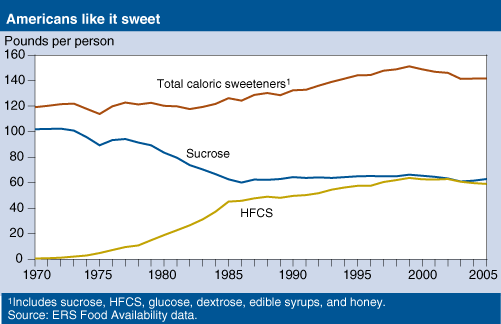High-Fructose Corn Syrup Usage May Be Leveling Off
- by Hodan Farah Wells and Jean C. Buzby
- 2/1/2008
Over the past 35 years, the total amount of added sugars and caloric sweeteners available in the U.S. food supply grew 19 percent, from 119 pounds per person in 1970 to 142 pounds per person in 2005, according to ERS’s per capita food availability data. The data are calculated by dividing the total annual supply of a commodity by the U.S. population for that year. Although these estimates do not directly measure actual quantities ingested, they provide an indication of whether Americans, on average, are consuming more or less of various foods over time.
During most of 1970 to 2005, the big story was that corn sweeteners—mostly high-fructose corn syrup (HFCS)—were replacing refined cane and beet sugars. HFCS is corn syrup that has been processed to increase the fructose content and then blended with pure corn syrup. Since its introduction in 1967, HFCS availability rose sharply to a peak of 63.7 pounds per person in 1999. Over the same time period, per capita availability of refined cane and beet sugars (sucrose) declined 33 percent.
HFCS’s lower cost is one of the main reasons for its substitution for sucrose. Industry analysts report that, on a sweetness equivalent/dry basis, HFCS-42 (one of the blends of HFCS) cost an average of 13.6 cents per pound in 2005, while the price of wholesale refined beet sugar averaged 29.5 cents per pound. Also, because HFCS is a liquid, it is easier to blend into many foods than sugar. HFCS is commonly used to sweeten soft drinks, sport drinks, and numerous processed foods, such as ketchup, crackers, bread, soups, cereals, and spaghetti sauce.
Since peaking in 1999, however, HFCS availability has dropped to 59 pounds per person in 2005, as no-calorie bottled water and diet soft drinks have grown in popularity at the expense of regular carbonated soft drinks. Bottled water availability stood at 25.4 gallons per person in 2005, up 52 percent from 16.7 gallons in 2000. Diet soft drink availability grew during the same period by 16 percent, while availability of regular soft drinks declined nearly 10 percent. Food manufacturers’ expanding use of a combination of sugar alcohols, artificial sweeteners, and bulking agents in more foods is also contributing to decreased usage of HFCS. If the price differential between sugar and HFCS shrinks because of continued demand for corn-based ethanol, for example, manufacturers may adjust their use of HFCS and sugar.
This article is drawn from:
- Food Availability (Per Capita) Data System. (n.d.). U.S. Department of Agriculture, Economic Research Service.


